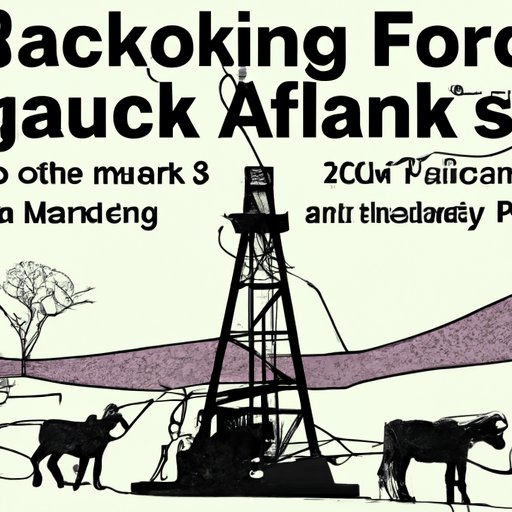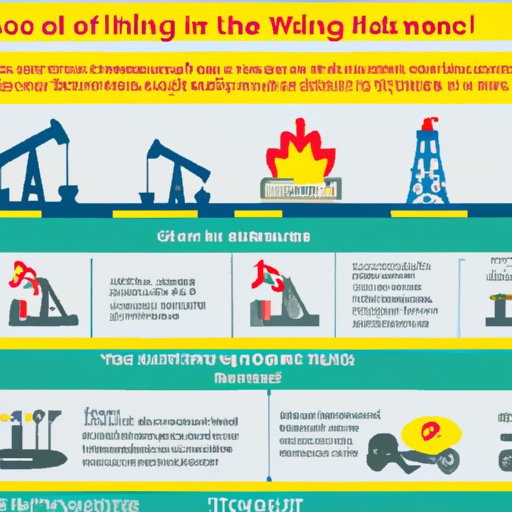Introduction
Fracking is a process used in oil and gas extraction that involves drilling into underground formations and injecting water, sand, and other substances at high pressure to break apart rocks and release trapped hydrocarbons. The term “fracking” is short for hydraulic fracturing, which is the process by which this technique is performed. This article will explore the history of fracking, when it was invented, and how it changed the world.
A Historical Analysis of Fracking: When Was It Invented?
The idea of fracking has been around since the 1940s, when scientists first began experimenting with the concept of using high-pressure fluids to fracture rocks in order to extract natural resources. These experiments led to the development of the technology necessary to perform hydraulic fracturing, and eventually, the first commercial use of the technology in 1949.

How Fracking Changed the World: A Look at Its Invention History
Since its invention, fracking has had a major impact on energy production, the environment, and the economy. Before fracking, conventional oil and gas wells were limited in their ability to access trapped hydrocarbons, meaning that only a fraction of available resources could be recovered. With the introduction of fracking, however, more oil and gas could be accessed, leading to an increase in energy production.
At the same time, fracking has raised environmental concerns. Fracking requires large amounts of water and chemicals, which can lead to contamination of nearby groundwater sources. Additionally, fracking has been linked to increased seismic activity, as well as air and noise pollution. Despite these concerns, fracking continues to be used as a means of extracting oil and gas, and has become an important part of the global energy market.
From an economic perspective, fracking has been a boon for many countries. By increasing the availability of energy resources, fracking has enabled countries to reduce their reliance on imported oil and gas, leading to cost savings and greater energy security. Additionally, fracking has created jobs and boosted local economies, particularly in areas where shale formations are abundant. According to a study by the American Petroleum Institute, the oil and gas industry supported 10.3 million jobs in 2015, with many of those jobs being related to fracking.
The Evolution of Fracking: Tracing Its Origins to Present Day
Since its invention, fracking has gone through several stages of development. Initially, fracking was a slow and expensive process, and was only used to access hard-to-reach reserves. However, advances in technology have made fracking easier, faster, and more cost effective. This has led to an expansion of its use, with fracking now being used to access a wide range of resources, including oil, gas, and coal.
Fracking has also become increasingly controversial in recent years. Environmentalists have raised concerns about the potential impacts of fracking on air and water quality, while some communities have voiced opposition to fracking due to its potential health and safety risks. Despite these controversies, fracking remains a popular method of energy production, and is likely to remain so in the future.
Unveiling the Mystery Behind Fracking: When Did It Begin?
The exact origin of fracking is difficult to pinpoint, as there are no records of its earliest uses. However, it is believed that the earliest ideas and experiments related to fracking date back to the 1940s. During this period, scientists began experimenting with the concept of using high-pressure fluids to fracture rocks in order to extract natural resources. These experiments laid the groundwork for the development of the technology needed to perform hydraulic fracturing.
In the 1950s, further developments in fracking technology began to take place. Scientists continued to experiment with the concept, and eventually, the first commercial use of fracking occurred in 1949. This breakthrough moment marked the beginning of the modern fracking industry, and paved the way for the widespread use of fracking today.
Exploring the Past: When Did Fracking First Come About?
The earliest experiments related to fracking took place in the 1940s, but it wasn’t until 1949 that the first commercial use of fracking occurred. This breakthrough moment marked the beginning of the modern fracking industry, and ushered in a new era of energy production. Since then, fracking has become increasingly popular and widespread, with the technology advancing rapidly over the past few decades.
The first commercial use of fracking in 1949 was followed by a period of experimentation and refinement of the process. During the 1960s and 1970s, fracking technology was further developed, and the first offshore fracking operations were conducted. In the 1980s, advances in technology allowed for the rapid expansion of fracking operations, leading to its widespread use today.
From Idea to Reality: A Timeline of Fracking’s Invention
The invention of fracking has been a long and complex process, with its origins stretching back to the 1940s. Here is a brief timeline of the key events in fracking’s invention history:
- 1940s: Initial experiments with the concept of using high-pressure fluids to fracture rocks in order to extract natural resources.
- 1949: First commercial use of fracking.
- 1960s-1970s: Further development of fracking technology and the first offshore fracking operations.
- 1980s: Advances in technology allow for the rapid expansion of fracking operations.
- Present day: Fracking is a widely used method of energy production.
Conclusion
Fracking has been around for nearly 70 years, and its invention has had a major impact on the world. From increasing energy production to creating jobs and boosting local economies, fracking has changed the way we produce and consume energy. Although it has faced criticism from environmentalists and some communities, fracking remains a popular and widely used method of energy production.
This article has explored the history of fracking and when it was invented. It has traced its origins from early ideas to present day, examined its impact on world today, and looked at the future of fracking. Ultimately, it is clear that fracking is here to stay, and its invention has revolutionized the energy industry.
(Note: Is this article not meeting your expectations? Do you have knowledge or insights to share? Unlock new opportunities and expand your reach by joining our authors team. Click Registration to join us and share your expertise with our readers.)
